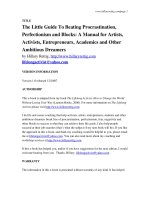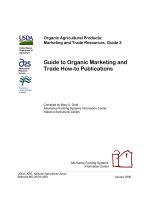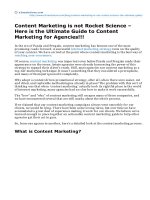THE ESSENTIAL STEP-BY-STEP GUIDE TO INTERNET MARKETING - The building blocks for succeeding with online marketing potx
Bạn đang xem bản rút gọn của tài liệu. Xem và tải ngay bản đầy đủ của tài liệu tại đây (1.54 MB, 67 trang )
the essential step-by-step guide to internet marketing
1
WWW.HUBSPOT.COM
Share This Ebook!
THE ESSENTIAL STEP-BY-STEP
GUIDE TO
INTERNET
MARKETING
The Building
Blocks for
Succeeding with
Online Marketing
A publication of
the essential step-by-step guide to internet marketing
2
WWW.HUBSPOT.COM
Share This Ebook!
Introductory content is for marketers who are new to the subject.
This content typically includes step-by-step instructions on how
to get started with this aspect of inbound marketing and learn its
fundamentals. After reading it, you will be able to execute basic
marketing tactics related to the topic.
INTRODUCTORY
IS THIS BOOK RIGHT FOR ME?
Not quite sure if this ebook is right for you? See the below description to determine if
your level matches the content you are about to read.
Intermediate content is for marketers who are familiar with the
subject but have only basic experience in executing strategies and
tactics on the topic. This content typically covers the fundamentals
and moves on to reveal more complex functions and examples.
Read our intermediate-level ebook “10 Commandments of
Marketing Automation.”
INTERMEDIATE
Advanced content is for marketers who are, or want to be, experts
on the subject. In it, we walk you through advanced features of
this aspect of inbound marketing and help you develop complete
mastery of the subject. After reading it, you will feel ready not only
to execute strategies and tactics, but also to teach others how to
be successful.
ADVANCED
the essential step-by-step guide to internet marketing
3
WWW.HUBSPOT.COM
Share This Ebook!
brings your whole marketing world to-
gether in one, powerful, integrated system.
HUBSPOT’S ALL-IN-ONE
MARKETING SOFTWARE
Get Found: Help prospects nd you online
Convert: Nurture your leads and drive conversions
Analyze: Measure and improve your marketing
Plus more apps and integrations
LEAD
GENERATION
U
BLOGGING &
SOCIAL MEDIA
q
EMAIL &
AUTOMATION
M
SEARCH
OPTIMIZATION
s
MARKETING
ANALYTICS
Y
LEAD
MANAGEMENT
g
Request A Demo Video Overview
the essential step-by-step guide to internet marketing
4
WWW.HUBSPOT.COM
Share This Ebook!
THE ESSENTIAL STEP-BY-STEP
GUIDE TO INTERNET MARKETING
By Pamela Vaughan
Pamela Vaughan manages the HubSpot Inbound
Marketing Blog and focuses on various content
creation projects, including ebooks. She graduated
with a Bachelor of Science in public relations from
Boston University’s College of Communication in
May 2008.
Pamela began her role as PR manager at HubSpot
in September 2008 and primarily managed the
content on HubSpot’s Company and Product News
Blog as well as HubSpot’s award nominations,
speaking engagements, and PR opportunities.
She has since worked on HubSpot’s product
evangelism team, managing the production of
customer case studies as well as HubSpot’s group
demos, and also contributed greatly to HubSpot’s
social media presence on Facebook and Twitter.
FOLLOW ME ON TWITTER
@PAMELUMP
the essential step-by-step guide to internet marketing
5
WWW.HUBSPOT.COM
Share This Ebook!
CREATE A KEYWORD STRATEGY /7
OPTIMIZE YOUR WEBSITE TO GET FOUND /12
CREATE A BLOG & MARKETING OFFERS /24
PROMOTE CONTENT THROUGH SOCIAL MEDIA /32
CONVERT WEBSITE TRAFFIC INTO LEADS /38
NURTURE LEADS WITH TARGETED MESSAGES /45
OPTIMIZE YOUR MARKETING FOR MOBILE VIEWING /53
ANALYZE & REFINE STRATEGIES /57
CONCLUSION & ADDITIONAL RESOURCES /65
CONTENTS
the essential step-by-step guide to internet marketing
6
WWW.HUBSPOT.COM
Share This Ebook!
Traditional marketing
methods are becoming
both ineffective and
expensive.
“
”
If you’re reading this ebook, chances are you’re either a marketing professional or a
business owner who understands the importance of internet marketing today. You
‘get’ that traditional marketing methods are becoming both ineffective and expen-
sive, and you know that by neglecting to market your business online, you’re missing
out on the powerful business results that an effective internet marketing strategy can
bring about.
Whether your business is just getting started with internet marketing or you just want
to brush up on the basics, this ebook can serve as your essential guide to setting up
and implementing a successful internet marketing strategy, step by step.
From establishing your initial keyword strategy and leveraging social media to pro-
mote content online all the way through to analyzing and rening your strategies, this
comprehensive internet marketing ebook will guide you through every essential step
you should be taking to effectively market your business online, whether you’re a
software company, a chimney sweep, a tailor, or a marketing agency, to name a few.
the essential step-by-step guide to internet marketing
7
WWW.HUBSPOT.COM
Share This Ebook!
STEP 1
CREATE A
KEYWORD
STRATEGY
the essential step-by-step guide to internet marketing
8
WWW.HUBSPOT.COM
Share This Ebook!
“
”
WHAT IS A KEYWORD?
A keyword is a word or phrase that a person uses to gather information on a topic online. People
can enter keywords into search engines like Google and Bing or social media sites like Face-
book, Twitter, and LinkedIn.
WHY BUILD A KEYWORD STRATEGY?
More and more consumers are nding businesses online through keyword
search. You can take advantage of this consumer habit by optimizing your
website and social media proles around the keywords that are relevant to
your business and that consumers are using to nd you online.
If you wanted to boil internet
marketing down to single starting
point, keywords are it.
K
the essential step-by-step guide to internet marketing
9
WWW.HUBSPOT.COM
Share This Ebook!
This will increase your chances of getting found by
people searching with those keywords, which will
drive more and better quality trafc to your busi-
ness’ website.
While it’s difcult to know exactly which keywords
will get the most relevant people to nd your busi-
ness, there are ways to determine the popularity
and competitiveness of certain keywords. You can
also test and analyze how effective different key-
words are in drawing visitors to your site.
As a business professional, you should make sure the right
people are nding your business online. In this section, you
will learn how to dene which keywords will maximize your
potential to draw in relevant trafc from search engines.
Keyword research is an ongoing process that should be followed closely.
It gives valuable insight on industry trends and product demand. Com-
prehensive keyword research can help you grow your organic trafc and
save you from spending money on pay-per-click (PPC) campaigns such
as Google AdWords.
the essential step-by-step guide to internet marketing
10
WWW.HUBSPOT.COM
Share This Ebook!
CREATE A LIST OF 3-5 KEYWORDS RELEVANT TO YOUR BUSINESS
Think like you’re using the brain of someone searching for your product online, through
a search engine or on social media. For small- and medium-sized businesses, your
keywords are not your brand name. Instead, think of words and short phrases that get
to the core of what your product or service is about.
CHOOSE KEYWORDS BASED ON DIFFICULTY AND RELEVANCE
The keywords you choose should be based on dif-
culty and relevance. Some very general words,
such as “marketing” or “business,” are very com-
petitive, making it harder to rank well for them in
search engine results. If you are a small- to medi-
um-sized business, you should choose less com-
petitive keywords, more specically related to your
business (these are commonly referred to as long-
tail keywords). The greater the volume of searches
on a keyword, the more competitive it is.
HOW TO CREATE A KEYWORD STRATEGY
K
W
K
the essential step-by-step guide to internet marketing
11
WWW.HUBSPOT.COM
Share This Ebook!
There are a number of different tools you can use to determine the competitiveness of a specic
keyword as well as suggest and help you brainstorm new keyword ideas. These tools include the
Google Keyword Tool or HubSpot’s Keyword tool.
Another important factor for picking keywords is their relevance to your business. While some
obscure terms might be easy to rank for, they might not be relevant to your business.
You should nd a balance between relevance and difculty. Choose keywords that match your
business well. Note that these keywords don’t have to be perfect at rst. You can try out different
ones to see which work best for you.
DESIGN AND OPTIMIZE YOUR WEBSITE AROUND YOUR KEYWORDS
Now that you’ve chosen your keywords, you should incorporate them into your website.
Optimize your website to include mentions of these words in key places. For instance,
the images you use, especially those on the home page, should include alt text that
reects your keyword strategy.
K
the essential step-by-step guide to internet marketing
12
WWW.HUBSPOT.COM
Share This Ebook!
STEP 2
OPTIMIZE YOUR
WEBSITE TO
GET FOUND
the essential step-by-step guide to internet marketing
13
WWW.HUBSPOT.COM
Share This Ebook!
Now that you’ve chosen your keywords, you should increase
your website’s chances of ranking for those keywords. Search
engine optimization (SEO) is about doing just that!
In order to get found through search engines, you should aim
to be on the rst page or in the rst few results pages for your
keywords. Today that is easier to achieve than a couple of years
ago thanks to social media. If you have created a Google+
business account, for instance, that will be immensely helpful
in your SEO efforts. That is why you need to make sure you are
optimizing all your social media proles to include updates with
major industry keywords.
Google suggests that you design your website for visitors, and not for search engines. While you
should keep this principle in mind, it is worthwhile to learn a bit more about SEO in order to bet-
ter optimize your site.
“
”
Aim to be on the rst page.
s
the essential step-by-step guide to internet marketing
14
WWW.HUBSPOT.COM
Share This Ebook!
WHAT YOU SHOULD KNOW ABOUT SEO
SEO can be divided into two categories: on-page SEO and off-page SEO.
ON-PAGE SEO
On-page SEO refers to how well your website’s content is presented to search engines.
This can often be improved immediately.
OFF-PAGE SEO
Off-page SEO refers to your site’s overall “authority” on
the web, which is determined by what other websites
say about your site. This can take time to improve.
Even though on-page SEO accounts for only about 25%
of how search engines score and rank your website,
it’s worth tackling rst since it can be improved quickly.
TEST YOUR SEO WITH MARKETINGGRADER
Find out how well optimized your website is by running it through HubSpot’s free tool, Marketing-
Grader. This tool will analyze your entire marketing and provide you with an overall score between
0 and 100. At this stage, you might focus on the Top-Of-The-Funnel (ToFu) result you get, but we
encourage you to also take a look at the rest of the data from your report. It will include some
ideas on how you can boost conversions and strengthen your entire marketing program.
Score: 73
out of 100
the essential step-by-step guide to internet marketing
15
WWW.HUBSPOT.COM
Share This Ebook!
9 ELEMENTS OF ON-PAGE WEBSITE OPTIMIZATION
PAGE TITLE
Page titles are one of the most important on-page SEO factors. They are the text you see at the
top of your browser window when viewing a web page. They are also the title of a page that is
presented in search engines.
Page titles can be found and edited in your site’s HTML. The text that is surrounded with the
<title> tag is your page’s title. Here are some guidelines for coming up with effective page titles:
Include keywords.
Make it fewer than 70 characters long. Longer page titles will not be seen in your web
browser or in Google search results. If you make the page title too long, it will also di-
lute the importance of the keywords mentioned.
Place keywords as close to the beginning of the title as possible.
Make it readable for site visitors.
Include your company name at the end of the page title, unless you are a big brand and
people search for you through your brand name.
Use different page titles for each page. Each page is an opportunity to target keywords.
2
2
2
2
2
2
the essential step-by-step guide to internet marketing
16
WWW.HUBSPOT.COM
Share This Ebook!
META DESCRIPTION & META DATA
Meta data does not directly inuence search engine rankings. Nevertheless, it is a good practice
to include keywords in your meta description.
Meta data is the text seen as the description of a site in Google search. These words attract a
searcher’s attention and indicate if a search result is particularly relevant to the searcher. For
this reason, including keywords in your meta description can draw in visitors.
The meta description is not something that is visible on your web page. The short summary of
the web page, which is usually included at the top of the pages source code in a <meta descrip-
tion> tag is not used by the search engines for any SEO purposes. What the meta description is
used for is to provide the searcher with a short description of the page (<150 characters to be
exact) beneath each result. In fact, if a meta description is not included in the source code, then
the search engine will usually display part of the content from the page in its place.
the essential step-by-step guide to internet marketing
17
WWW.HUBSPOT.COM
Share This Ebook!
HEADINGS
If a piece of text appears larger or more prominent than the other text on a page, it’s probably
part of a heading. You can verify this by checking the HTML code of your website and looking for
text with an <h1>, <h2>, or <h3> tag surrounding it.
Text in the headings is more likely to be read by search engines as keywords than text in the
rest of the page. For this reason, it is good to include keywords in your headings whenever pos-
sible. <h1> tags give the text more weight as keywords than <h2> tags, and <h2> tags have
more weight than <h3> tags. While <h4> and <h5> tags do exist, their inuence on keywords is
virtually the same as that of regular text. Including too many headings dilutes the importance of
keywords in other headings, so we recommend using the <h1> tag only once. If the page is text-
heavy like a blog post, then feel free to throw in a few <h2> or <h3> tags as paragraph titles.
HEADING
the essential step-by-step guide to internet marketing
18
WWW.HUBSPOT.COM
Share This Ebook!
CASCADING STYLE SHEETS (CSS)
HTML is the back-end code of your website that search engines read. Search engines extract rel-
evant information, such as keywords, from your HTML. CSS, on the other hand, holds a template
for the layout of your page. In the CSS, you dene how headings, links, and other visual elements
of the text should look. The takeaway here is simple: use CSS. Putting layout-related information
in your HTML can dilute the relevance of the HTML text, which is what you want search engines
to read.
IMAGES
Images on a web page can enhance user experience. When insert-
ing images into your website, however, you should keep in mind the
following:
Don’t use images excessively. More pictures can slow down the loading of your page,
thus negatively impacting both user experience and search engine optimization.
Associate text with pictures. Search engines do not ‘read’ images; they read only
text. ALT text is an HTML attribute you can add to your picture so search engines re-
place the image with some associated text.
Include keywords in your image le name. This will help you draw in relevant trafc
from image searches. Separate keywords in the le name with a dash (-).
2
2
2
P
the essential step-by-step guide to internet marketing
19
WWW.HUBSPOT.COM
Share This Ebook!
DOMAIN INFO
Search engine rankings favor sites that are registered for a long period of time. Long domain reg-
istrations indicate a commitment to the site, a signal that the site has a lower chance of being
spam. Extend your website registration for $10-20 a year for an SEO boost.
MOZ RANK
MOZ Rank is a general measure of how much online authority your site has. A higher MOZ rank
is better. Note that MOZ Rank factors in both on-page and off-page SEO. Improving your on-page
SEO may help improve your rank, but there is much more you can do to improve it. Don’t worry,
we will get to all this.
GOOGLE CRAWL DATE
When Google crawls your site, it updates the information related to it, such as your keywords and
other SEO factors. Therefore, you want Google to crawl your site as often as possible.
The best thing you can do to make Google crawl your site more frequently is to regularly produce
fresh content and publish it on your website.
the essential step-by-step guide to internet marketing
20
WWW.HUBSPOT.COM
Share This Ebook!
URL STRUCTURE
The URL of a web page is its web address. For example, HubSpot’s blog has a URL of http://
blog.hubspot.com. The URL structure of a website is about how the different URLs connect with
each other.
Unfortunately, improving your URL structure is one of the more difcult aspects of on-page web-
site optimization. The methods of xing these issues depend entirely on the back-end parts of
your website, such as your content management system or programming framework. Neverthe-
less, if you have a competent developer by your side, having him or her tackle these issues can
signicantly improve your SEO.
AVOID KEYWORD STUFFING
After reading this, you might think, “Keywords are really im-
portant. If having keywords all over my page helps me rank for
them, I should just ll my page with these keywords.”
It’s not that easy. Apart from leading to a bad experience for site visitors, search engines are
smart enough to detect these behaviors. Trying to trick search engines is not a good SEO strat-
egy, and sacricing readability for SEO is not a good idea either.
d
the essential step-by-step guide to internet marketing
21
WWW.HUBSPOT.COM
Share This Ebook!
IMPROVING OFF-PAGE SEO WITH INBOUND LINKS
If on-page SEO accounts for 25% of your overall
search engine ranking, what makes up the remain-
ing 75%? As we mentioned before, off-page SEO
is based on the authority of your website, or what
other websites ‘say’ about yours. Simply put, web-
sites with better or higher authority will rank better
than websites with lower authority.
Inbound links are key inuencers on a website’s authority. When another website links to a page
on your website, that is called an inbound link. More inbound links is better, and more inbound
links from websites with high authority is even better (e.g., an inbound link from The New York
Times’ website is much more valuable than an inbound link from a low-trafcked blog with a
small readership).
So what’s the best way to attract more inbound links (or ‘link love,’ as we like to call it)? Through
content creation! Creating valuable, remarkable content that other websites will naturally want
to link to in their own content is a great way to increase your website’s inbound links. In addition,
you can improve your chances of attracting inbound links by sharing your content in social media
and optimizing it for search results so it can easily be found.
A
the essential step-by-step guide to internet marketing
22
WWW.HUBSPOT.COM
Share This Ebook!
PRINCIPLES OF GOOD URL STRUCTURE
APPLY A 301 REDIRECT WHERE NECESSARY
A 301 redirect forwards an old URL to a new one. Make sure you do this if you
change the URL of a page on your site. A common mistake is not applying a 301
redirect between yoursite.com and www.yoursite.com. This can be quite a prob-
lem from an SEO standpoint, because search engines will give separate credit to
both versions of your site.
AVOID PAGES WITH DEEPLY NESTED URLS
Here is an example of what a deeply nested URL looks like: />about/management/contact/phone. Deeply nested pages will get less SEO credit.
You can x this problem by improving your overall site design.
INCLUDE KEYWORDS IN YOUR URLS
If you’ve already purchased your main URL, then don’t worry about buying a new
one just for this sake. But you can clean the URLs of your interior pages to include
keywords and not look like gibberish.
s
d
1
the essential step-by-step guide to internet marketing
23
WWW.HUBSPOT.COM
Share This Ebook!
SEPARATE KEYWORDS WITH DASHES
For your internal page URLs, separate individual keywords with dashes (-). For
example: is a good URL that captures
‘marketing’ and ‘resources’ as keywords.
CREATE STATIC URLS, NOT DYNAMIC ONES
A static URL is one that stays the same. As explained in this Webconfs article, a
dynamic URL looks like this:
A static URL looks like this:
/>You can nd how to create static URLs with your web server software: do a Google
search on “create static URL” + (name of your server software).
_
H
the essential step-by-step guide to internet marketing
24
WWW.HUBSPOT.COM
Share This Ebook!
STEP 3
CREATE A BLOG
& MARKETING
OFFERS
the essential step-by-step guide to internet marketing
25
WWW.HUBSPOT.COM
Share This Ebook!
Blogging platforms like HubSpot, WordPress and
Blogger have made publishing content on the web
easier than ever. Now that you have developed a
clear understanding of your business’ keywords
and optimized your website for search engines,
your next step should be to attract more visitors.
Blogging and creating other content like ebooks
and webinars are powerful ways to drive the right
people to your business online.
HOW TO THINK ABOUT BUSINESS BLOGGING
When blogging, take off your hat as a business owner or marketing manager and try to think like
a magazine publisher. The goal of your business blog should be to publish articles valuable and
non-promotional articles, much in the way a column or an article in an industry magazine would
be. Also, think about the words you are using. Avoid industry jargon that only your employees
would understand. Just as in the process of designing a keyword strategy, think of the words your
customers use to describe your business and apply those phrases to your blogging language.
Blogging is a powerful way to
help more people discover your
business online.
“
”









